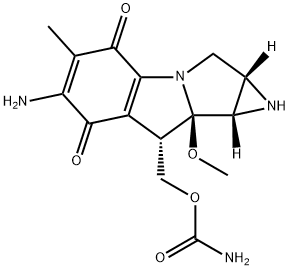미토미신 C C화학적 특성, 용도, 생산
개요
Mitomycin C is naturally produced by Streptomyces caespitosus,
an Actinobacteria found in soil. Mitomycin C has antibiotic
and antitumor activities and has been studied extensively since
the 1950s. A unique feature of this drug is strong bioreductive
alkylation under hypoxic conditions. Oxygen-poor cells
internal to solid tumors provide an environment in which this
drug is highly activated. As an antitumor agent, it has shown
efficacy in a wide variety of cancers, including gastric cancer,
pancreatic cancer, breast cancer, non-small-cell lung cancer,
cervical cancer, prostate cancer, and bladder cancer. The sideeffect
profile is large, which prohibits its widespread use.
Mitomycin C is antibacterial to gram-positive, gram-negative,
and acid-fast bacilli.
화학적 성질
Blue-violet crystals or crystalline powder.
용도
Mitomycin C is the most studied of a family of highly distinctive blue/purple metabolites produced by several Streptomyces species. Mitomyin C exhibits potent antibacterial and antitumour activity and inhibits DNA synthesis by intercalation, blocking nuclear division with the induction of apoptosis in cancer cells.
정의
Antibiotic derivedfrom Streptomyces, stated to be effective againsttumors.
Indications
Mitomycin (mitomycin C, Mitocin-C, Mutamycin) is an
antibiotic that is derived from a species of Streptomyces.
It is sometimes classified as an alkylating agent because
it can covalently bind to and cross-link DNA.
Mitomycin is thought to inhibit DNA synthesis through
its ability to alkylate double-strand DNA and bring
about interstrand cross-linking. There is evidence that
enzymatic reduction by a reduced nicotinamide–
adenine dinucleotide phosphate (NADPH) dependent
reductase is necessary to activate the drug.
The drug is rapidly cleared from serum after intravenous
injection but is not distributed to the brain.
일반 설명
Blue-violet crystals. Used as an anti-tumor antibiotic complex.
공기와 물의 반응
Water soluble.
반응 프로필
Mitomycin C is sensitive to prolonged exposure to light. Mitomycin C may be sensitive to prolonged exposure to air. Mitomycin C is incompatible with strong oxidizing agents, strong acids and strong bases. Calcium salts may cause decomposition.
위험도
Possible carcinogen.
건강위험
Toxic doses as low as 750 mg/kg have been reported in humans. The major toxic effect is myelosuppression, characterized by marked leukopenia and thrombocytopenia; this may be delayed and cumulative. Interstitial pneumonia and glomerular damage resulting in kidney failure are unusual but well documented complications. Lung conditions -- administration of mitomycin has been recognized as causing pneumonitis, alveolitis and pulmonary fibrosis. Kidney conditions -- administration of Mitomycin Can cause kidney damage. Kidney toxicity was observed in 1-5 percent of patients. Depressed immune conditions.
화재위험
Flash point data for Mitomycin C are not available; however, Mitomycin C is probably combustible.
생물학적 활성
Antibiotic and antitumor agent. Covalently binds DNA forming intra- and interstrand crosslinks. Inhibits DNA synthesis.
Clinical Use
Mitomycin has limited palliative effects in carcinomas
of the stomach, pancreas, colon, breast, and cervix.
부작용
The major toxicity associated with mitomycin therapy
is unpredictably long and cumulative myelosuppression
that affects both white blood cells and
platelets. A syndrome of microangiopathic hemolytic
anemia, thrombocytopenia, and renal failure also has
been described. Renal, hepatic, and pulmonary toxicity
may occur. The drug is teratogenic and carcinogenic,
and it can cause local blistering.
잠재적 노출
This compound is an antitumor antibiotic
complex. This drug is usually injected intravenously.
환경귀착
Mitomycin C is naturally produced by S. caespitosus, a microorganism
found in soil and decaying vegetation. As
a compound potentially released in commercial solid waste or
in spill or container residue, mitomycin C is not thought to
persist in soil and water. Calculations based on its hydrolysis
rate in water at 25 ℃ show a half-life of 12.9 days. It is readily
soluble in water, so mobility in groundwater is high. Mitomycin
persistence in air is low and bioaccumulation is low.
신진 대사
Mitomycin is administered IV in the treatment of disseminated adenocarcinoma of the stomach or pancreas, and it has been used intravesically in superficial bladder cancer. Biotransformation pathways are saturable, and approximately 10% of an administered dose is eliminated unchanged via the kidneys.
운송 방법
UN2811 Toxic solids, organic, n.o.s., Hazard
Class: 6.1; Labels: 6.1-Poisonous materials, Technical
Name Required. UN3249 Medicine, solid, toxic, n.o.s.,
Hazard Class: 6.1; Labels: 6.1-Poisonous materials.
Purification Methods
Mitomycin C forms blue-violet crystals from *C6H6/pet ether. It is soluble in Me2CO, MeOH and H2O, moderately soluble in *C6H6, CCl4 and Et2O but insoluble in pet ether. It has UV max at 216, 360 and a weak peak at 560nm in MeOH. [Stevens et al. J Med Chem 8 1 1965, Shirahata & Hirayama J Am Chem Soc 105 7199 1983, Beilstein 25 III/IV 516.]
비 호환성
Incompatible with oxidizers (chlorates,
nitrates, peroxides, permanganates, perchlorates, chlorine,
bromine, fluorine, etc.); contact may cause fires or explosions.
Keep away from alkaline materials, strong bases,
strong acids, oxoacids, epoxides, heat, strong light, calcium
salts.
폐기물 처리
Consult with environmental
regulatory agencies for guidance on acceptable disposal
practices. Generators of waste containing this contaminant
(≥100 kg/mo) must conform to EPA regulations governing
storage, transportation, treatment, and waste disposal.
It is inappropriate and possibly dangerous to the environment
to dispose of expired or waste drugs and pharmaceuticals
by flushing them down the toilet or discarding them
to the trash. Household quantities of expired or waste
pharmaceuticals may be mixed with wet cat litter or coffee
grounds, double-bagged in plastic, discard in trash.
Larger quantities shall carefully take into consideration
applicable DEA, EPA, and FDA regulations. If possible
return the pharmaceutical to the manufacturer for proper
disposal being careful to properly label and securely package
the material. Alternatively, the waste pharmaceutical
shall be labeled, securely packaged, and transported by a
state licensed medical waste contractor to dispose by
burial in a licensed hazardous or toxic waste landfill or
incinerator.
미토미신 C 준비 용품 및 원자재
원자재
준비 용품








